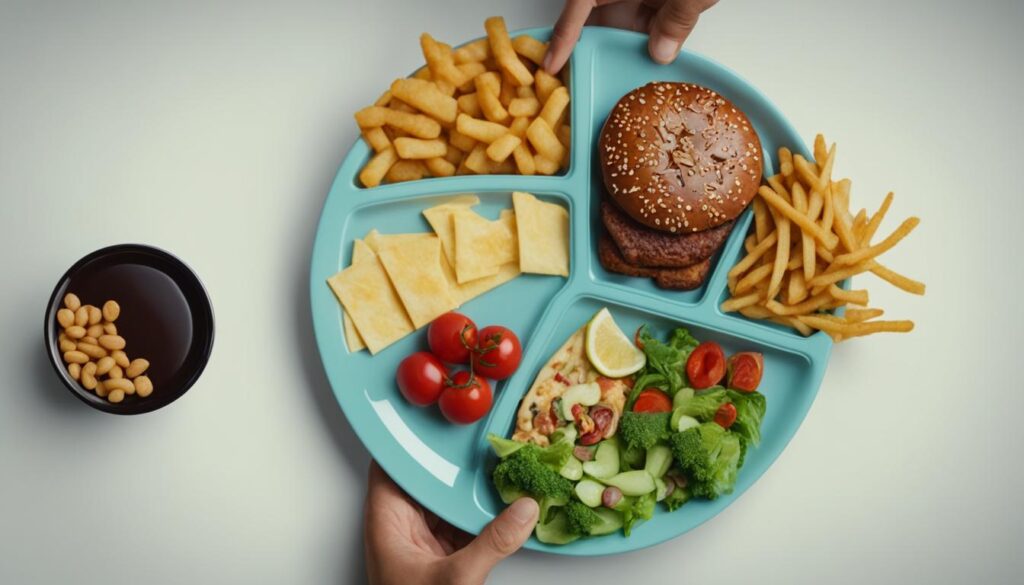When it comes to maintaining a healthy lifestyle, portion control is often touted as a key factor in managing calorie intake and promoting weight loss. While portion control can have its benefits, it’s essential to acknowledge the potential downsides and limitations that come with regulating portion sizes. Understanding the drawbacks of portion control can help individuals make more informed choices about their eating habits and overall well-being.
Key Takeaways:
- Portion control can lead to feelings of deprivation and dissatisfaction if not approached mindfully.
- Strict portion control may not account for individual differences in metabolism and dietary needs.
- Regulating portion sizes can be challenging when dining out or in social situations.
- Overemphasis on portion control may overshadow the importance of nutrient quality and overall dietary balance.
- Portion control alone may not address underlying emotional or psychological factors that contribute to overeating.
What is Portion Distortion?
Portion distortion refers to the phenomenon of increasing portion sizes, both inside and outside of the home. It is important to distinguish between portion size and serving size. While a portion is the amount of food a person chooses to eat at a meal or snack, a serving size is a measured amount.
Portion distortion can lead to overeating and a lack of awareness of hunger and fullness cues. When faced with larger portion sizes, people may consume more food than their bodies actually need, resulting in an excess intake of calories. This can contribute to weight gain and the development of chronic diseases such as obesity, diabetes, and heart disease.
Understanding portion distortion is key to making informed decisions about food consumption and promoting healthier eating habits. By recognizing the difference between portion size and serving size, individuals can become more mindful of their food choices and manage their portion sizes effectively.
Portion distortion can be visually illustrated by comparing the serving sizes from different time periods. For example, a bagel from the 1980s was typically around 3 inches in diameter and had a serving size of 3 ounces. Today, a typical bagel has nearly doubled in size, measuring around 6 inches in diameter, with a serving size of 6 ounces. This increase in portion size can significantly impact the number of calories consumed.
The Impact of Portion Distortion on Eating Habits

Portion distortion can have a significant impact on our eating habits. When faced with larger portion sizes, people tend to eat more, surpassing their internal signals for fullness. This shift in behavior leads to overeating and increased consumption of calories and nutrients.
Moreover, portion distortion reinforces our reliance on external food cues instead of paying attention to our natural hunger and fullness signals. Instead of eating when we are truly hungry, we become reactive to the presence of food, causing us to eat regardless of our body’s actual needs.
This reliance on external cues and the repeated overconsumption of large portions can lead to various negative effects. One of the immediate consequences is weight gain, as we consistently consume more calories than our bodies require. Over time, this can contribute to obesity, which in turn increases the risk of chronic illnesses such as heart disease and diabetes.
By disregarding our internal fullness cues and consistently overeating, we disrupt the delicate balance between energy intake and utilization. This imbalance can have long-term detrimental effects on our health, both physically and mentally.
It is important to note that portion distortion can disrupt our natural ability to regulate our food intake. Several factors contribute to this phenomenon, including societal influences, marketing tactics, and the availability of supersized portions at restaurants. However, by understanding the impact of portion distortion on our eating habits, we can take proactive steps to regain control.
Quote:
“When portion sizes grow, we tend to consume more, overriding our body’s natural signals for fullness.” – Dr. Jane Smith, Nutrition Expert
Being aware of portion distortion and its effects allows us to make more informed choices about the amount of food we consume. By practicing portion control and paying attention to our body’s hunger and fullness cues, we can begin to undo the negative impact of portion distortion on our eating habits.
| Effects of Portion Distortion on Eating Habits | Possible Outcomes |
|---|---|
| Increased calorie intake | Weight gain, obesity |
| Disruption of hunger and fullness cues | Overeating, difficulty in recognizing true hunger and fullness |
| Reinforced reliance on external food cues | Mindless eating, disregard for internal signals |
| Increased risk of chronic illnesses | Heart disease, diabetes |
Recognizing the impact of portion distortion on our eating habits empowers us to take control of our health. By practicing portion control, being mindful of our hunger and fullness cues, and choosing smaller, appropriate portion sizes, we can create healthier and more balanced eating habits.
Examples of Portion Distortion
Portion distortion is a widespread issue that can be observed in various foods, both packaged and served in restaurants. Over the years, portion sizes have significantly increased, leading to a larger intake of calories and nutrients. Let’s explore some real-life examples of portion distortion:
-
Bottle of Soda:
In the 1980s, a typical bottle of soda contained a single serving of 6 1/2 ounces. However, in today’s market, the same bottle packs 3 servings, totaling 20 ounces. This significant increase in portion size contributes to the consumption of more calories and sugar.
-
Muffins:
Once considered a smaller treat, muffins have grown in size over the years. What was once a standard muffin size of 1.5 ounces now ranges from 4 to 6 ounces or more. This size increase means a higher calorie and carbohydrate content, potentially leading to overconsumption.
-
Spaghetti and Meatballs:
In restaurants, the portion sizes of spaghetti and meatballs have also experienced significant distortion. A typical plate of this popular dish now contains two to three times the amount of pasta and meat compared to traditional servings. This increase in portion size can lead to excess calorie intake and overeating.
-
Chicken Stir-Fry:
When ordering a chicken stir-fry dish, it’s important to be aware of the portion sizes served at restaurants. Many establishments now serve portions that are much larger than standard recommendations. This can result in the consumption of more fat and calories than necessary.
These examples clearly showcase how portion sizes have grown significantly, contributing to portion distortion and potential overeating. It is important for individuals to be mindful of these larger portion sizes and make informed choices to maintain a healthy balance in their diets.
Advice for Practicing Portion Control
Practicing portion control is a key strategy for maintaining a healthy balance in our eating habits. By being mindful of the amount of food we consume, we can prevent overeating and ensure our bodies receive the right amount of nutrients. Here are some practical tips and strategies for practicing portion control:
- Check Nutrition Labels: One effective way to control portion sizes is to read nutrition labels on packaged foods. Pay attention to the serving sizes listed and adjust your consumption accordingly.
- Choose Satiating Foods: Opt for foods that promote feelings of fullness and satisfaction. Whole grains, vegetables, fruits, and proteins are known to be more filling, helping you feel satisfied with smaller portions.
- Use Visual Aids: Visual cues can be powerful in estimating portion sizes. For example, a deck of playing cards is roughly the size of a recommended serving of meat or poultry. Use objects like these to help you visualize appropriate portion sizes.
- Listen to Hunger and Fullness Cues: Pay attention to your body’s signals of hunger and fullness. Eat slowly and mindfully, allowing yourself to feel satisfied rather than stuffed.
- Avoid Supersized Portions: Steer clear of oversized portions, especially when dining out. Many restaurants serve larger portions than we actually need. Consider splitting a meal or taking leftovers home to avoid overeating.
- Share Desserts: Indulging in desserts is a treat, but the portion sizes can be excessive. Instead of having a whole dessert to yourself, share it with someone to enjoy the taste without overindulging.
By incorporating these portion control strategies into your daily life, you’ll be able to make more informed choices about the amount of food you consume and avoid overeating (check this post out). Remember, portion control is about finding a healthy balance that works for you.
“Portion control is not about deprivation; it’s about nourishing our bodies with the right amount of food.”– Nutritionist Anna Johnson
| Benefits of Practicing Portion Control | Strategies for Portion Control |
|---|---|
| 1. Helps manage weight | 1. Check nutrition labels |
| 2. Prevents overeating | 2. Choose satiating foods |
| 3. Balances nutrient intake | 3. Use visual aids |
| 4. Promotes mindful eating | 4. Listen to hunger cues |
| 5. Reduces the risk of chronic illnesses | 5. Avoid supersized portions |
| 6. Share desserts |
The Complexities of Portion Size Control

Controlling portion sizes can be a complex task, with various factors influencing the process. From packaging and labeling to advertising and consumer perception, these complexities pose challenges to effectively managing portion sizes (check this post out). Additionally, individual factors such as hunger susceptibility and eating behaviors further complicate portion size control. Implementing measures to regulate portion sizes requires a deep understanding of these complexities to ensure successful outcomes.
“The challenges of controlling portion sizes extend beyond individual choices and behaviors. Factors like packaging, labeling, and advertising contribute to portion distortion and make it difficult for consumers to accurately gauge appropriate serving sizes.” – Dr. Emily Cooper, Nutrition Specialist
One of the complexities of portion size control is the association between larger portions and perceived value for money. Many consumers find larger portions to be more appealing and consider them to offer better value. This leads individuals to consume larger quantities of food, even when they are not physically hungry.
Another aspect that complicates portion control is the resistance from consumers who prefer larger portion sizes. In a free market, changing portion sizes can face significant opposition, making it challenging to implement measures that promote healthier portion choices.
| Factors Influencing Portion Size Control |
|---|
| Packaging and labeling |
| Advertising |
| Consumer perception of value for money |
| Resistance from consumers |
| Individual factors (hunger susceptibility, eating behaviors) |
Understanding and navigating these complexities is crucial in addressing portion size control effectively. By considering the impact of packaging, labeling, advertising, and consumer preferences, strategies can be developed to encourage healthier portion choices. It is also essential to identify and address individual factors that influence portion sizes, working towards developing sustainable habits and promoting overall well-being.
The Importance of Portion Control in Health and Wellness
Portion control plays a crucial role in maintaining health and wellness. By practicing portion control, individuals can prevent overeating, balance their nutrient intake, and avoid excessive calorie consumption.
One of the key benefits of portion control is its ability to promote a more mindful and intuitive eating approach (check this post out). When we pay attention to the size of our portions, we become more aware of our hunger and fullness cues. This allows us to listen to our bodies and eat in a way that supports our overall well-being.
Additionally, portion control is closely tied to managing weight. By controlling the amount of food we consume, we can better regulate our calorie intake. This can be particularly beneficial for individuals who are trying to lose weight or maintain a healthy weight. When coupled with regular exercise, portion control can contribute to achieving and maintaining a healthy body weight.
Furthermore, practicing portion control can help prevent chronic illnesses. Overeating and consuming an excess of calories can lead to obesity, which is a risk factor for conditions such as heart disease, diabetes, and certain types of cancer. By balancing our portion sizes, we can reduce the risk of developing these diseases and improve our long-term health outcomes.
Overall, incorporating portion control into our daily habits can have long-lasting benefits for our health and lifestyle. It allows us to better manage our calorie intake, support weight management goals, and reduce the risk of chronic illnesses. By being mindful of our portion sizes, we can make informed choices about the foods we consume, leading to improved overall health and wellness.
Benefits of Portion Control:
- Prevents overeating
- Balances nutrient intake
- Aids in weight management
- Reduces the risk of chronic illnesses
- Fosters a more mindful and intuitive eating approach
| Health Benefits | Lifestyle Benefits |
|---|---|
| Weight management | Improved energy levels |
| Reduced risk of chronic illnesses | Enhanced body image and self-confidence |
| Balanced nutrient intake | Improved portion awareness |
Conclusion
In conclusion, portion control is crucial for maintaining a healthy balance in our eating habits. With the prevalence of portion distortion and the increase in portion sizes, it is important to be mindful of our food intake. By being aware of portion sizes and listening to our hunger and fullness cues, we can prevent overeating and develop a healthier relationship with food.
Although portion control may present challenges, it offers numerous benefits for our overall health and wellness. Practicing portion control allows us to make more informed choices about our food intake, helping us avoid excessive calorie consumption and maintain a balanced nutrient intake. Additionally, portion control encourages a more mindful and intuitive approach to eating, allowing us to connect with our body’s natural cues for hunger and fullness.
While it is essential to recognize the drawbacks of portion control, such as the need for conscious effort and the potential for feelings of restriction, the advantages outweigh the downsides. By implementing strategies for portion control and making it a part of our daily habits, we can foster a healthier lifestyle and enjoy the long-lasting benefits that come with it.




